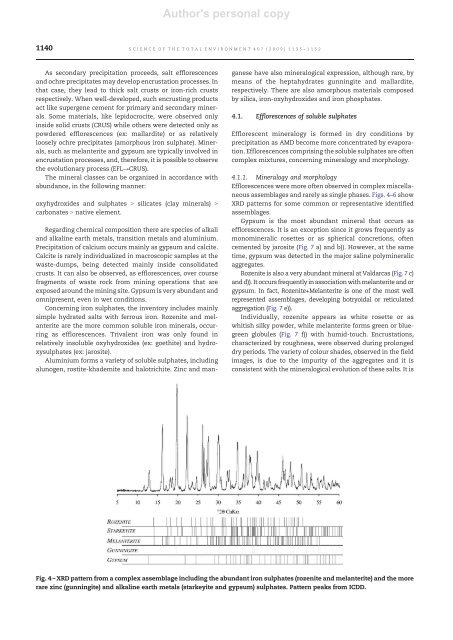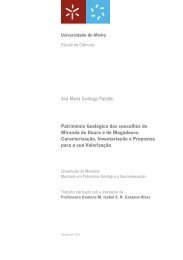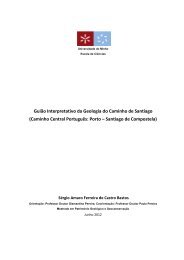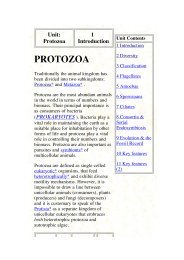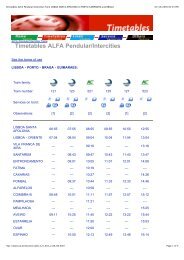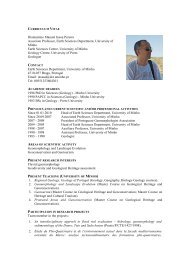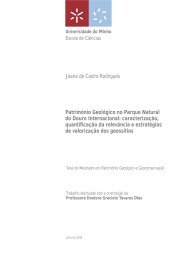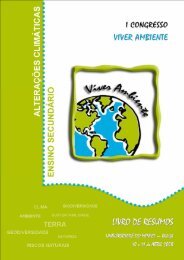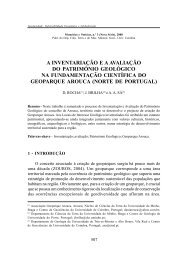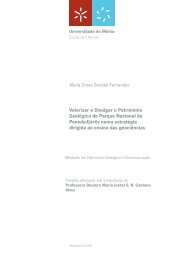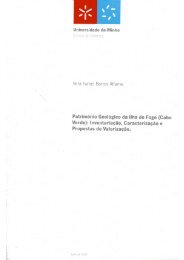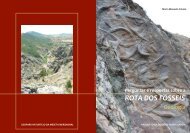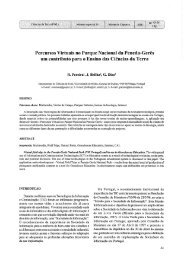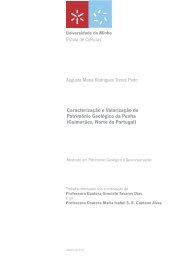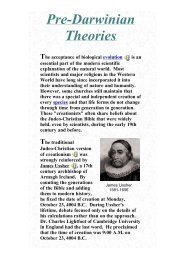Descarregue o Livro do Curso a partir daqui - Departamento de ...
Descarregue o Livro do Curso a partir daqui - Departamento de ...
Descarregue o Livro do Curso a partir daqui - Departamento de ...
Create successful ePaper yourself
Turn your PDF publications into a flip-book with our unique Google optimized e-Paper software.
Author's personal copy<br />
1140 SCIENCE OF THE TOTAL ENVIRONMENT 407 (2009) 1135– 1152<br />
As secondary precipitation proceeds, salt efflorescences<br />
and ochre precipitates may <strong>de</strong>velop encrustation processes. In<br />
that case, they lead to thick salt crusts or iron-rich crusts<br />
respectively. When well-<strong>de</strong>veloped, such encrusting products<br />
act like supergene cement for primary and secondary minerals.<br />
Some materials, like lepi<strong>do</strong>crocite, were observed only<br />
insi<strong>de</strong> solid crusts (CRUS) while others were <strong>de</strong>tected only as<br />
pow<strong>de</strong>red efflorescences (ex: mallardite) or as relatively<br />
loosely ochre precipitates (amorphous iron sulphate). Minerals,<br />
such as melanterite and gypsum are typically involved in<br />
encrustation processes, and, therefore, it is possible to observe<br />
the evolutionary process (EFL→CRUS).<br />
The mineral classes can be organized in accordance with<br />
abundance, in the following manner:<br />
oxyhydroxi<strong>de</strong>s and sulphates N silicates (clay minerals) N<br />
carbonates N native element.<br />
Regarding chemical composition there are species of alkali<br />
and alkaline earth metals, transition metals and aluminium.<br />
Precipitation of calcium occurs mainly as gypsum and calcite.<br />
Calcite is rarely individualized in macroscopic samples at the<br />
waste-dumps, being <strong>de</strong>tected mainly insi<strong>de</strong> consolidated<br />
crusts. It can also be observed, as efflorescences, over course<br />
fragments of waste rock from mining operations that are<br />
exposed around the mining site. Gypsum is very abundant and<br />
omnipresent, even in wet conditions.<br />
Concerning iron sulphates, the inventory inclu<strong>de</strong>s mainly<br />
simple hydrated salts with ferrous iron. Rozenite and melanterite<br />
are the more common soluble iron minerals, occurring<br />
as efflorescences. Trivalent iron was only found in<br />
relatively insoluble oxyhydroxi<strong>de</strong>s (ex: goethite) and hydroxysulphates<br />
(ex: jarosite).<br />
Aluminium forms a variety of soluble sulphates, including<br />
alunogen, rostite-kha<strong>de</strong>mite and halotrichite. Zinc and manganese<br />
have also mineralogical expression, although rare, by<br />
means of the heptahydrates gunningite and mallardite,<br />
respectively. There are also amorphous materials composed<br />
by silica, iron-oxyhydroxi<strong>de</strong>s and iron phosphates.<br />
4.1. Efflorescences of soluble sulphates<br />
Efflorescent mineralogy is formed in dry conditions by<br />
precipitation as AMD become more concentrated by evaporation.<br />
Efflorescences comprising the soluble sulphates are often<br />
complex mixtures, concerning mineralogy and morphology.<br />
4.1.1. Mineralogy and morphology<br />
Efflorescences were more often observed in complex miscellaneous<br />
assemblages and rarely as single phases. Figs. 4–6 show<br />
XRD patterns for some common or representative i<strong>de</strong>ntified<br />
assemblages.<br />
Gypsum is the most abundant mineral that occurs as<br />
efflorescences. It is an exception since it grows frequently as<br />
monomineralic rosettes or as spherical concretions, often<br />
cemented by jarosite (Fig. 7 a) and b)). However, at the same<br />
time, gypsum was <strong>de</strong>tected in the major saline polymineralic<br />
aggregates.<br />
Rozenite is also a very abundant mineral at Valdarcas (Fig. 7 c)<br />
and d)). It occurs frequently in association with melanterite and or<br />
gypsum. In fact, Rozenite+Melanterite is one of the most well<br />
represented assemblages, <strong>de</strong>veloping botryoidal or reticulated<br />
aggregation (Fig. 7 e)).<br />
Individually, rozenite appears as white rosette or as<br />
whitish silky pow<strong>de</strong>r, while melanterite forms green or bluegreen<br />
globules (Fig. 7 f)) with humid-touch. Encrustations,<br />
characterized by roughness, were observed during prolonged<br />
dry periods. The variety of colour sha<strong>de</strong>s, observed in the field<br />
images, is due to the impurity of the aggregates and it is<br />
consistent with the mineralogical evolution of these salts. It is<br />
Fig. 4 – XRD pattern from a complex assemblage including the abundant iron sulphates (rozenite and melanterite) and the more<br />
rare zinc (gunningite) and alkaline earth metals (starkeyite and gypsum) sulphates. Pattern peaks from ICDD.


